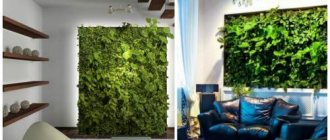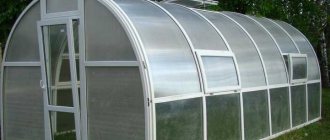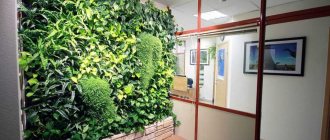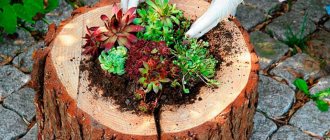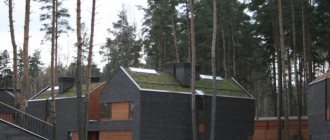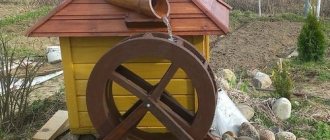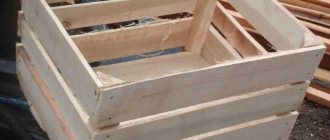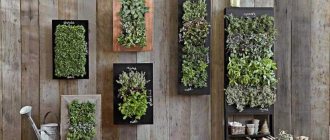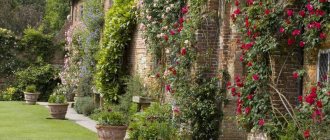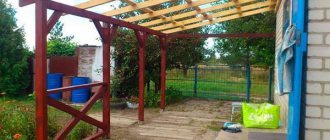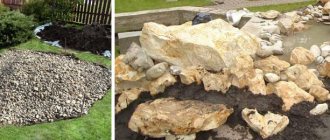What are the benefits of vertical gardening?
The described technique is the most popular element of landscape design. With its help, today you can solve several problems at once: disguise ugly walls on the site, highlight a certain functional area, place the necessary accents when implementing the chosen stylistic concept.
Vertical gardening works especially well where there is little space to organize a full-fledged garden. Greenery planted along steep surfaces will at the same time decorate, protect from overheating and protect from street noise, and provide coolness in hot weather. Lushly growing climbing plants always look very beautiful, so vertical gardening in landscape design is used very often as a decorative element.
With its help, experienced craftsmen create hedges, green backgrounds and walls of flowers. They separate individual areas of the landscape from each other and form additional protection for the garden from wind, dust and sun.
Corner of a green garden growing upward Source sfw.so
Methods of vertical gardening in the interior
Plants planted in a house area rushing up a support no longer surprise almost anyone. A similar solution looks more unusual in the interiors of apartments, houses and offices. The scale of landscaping and the choice of plants will be somewhat smaller, attractiveness will outweigh practicality, but the essence will change little.
"Living" wall in the interior of the store
Note! A “green” wall naturally creates the most favorable indoor microclimate for humans. Some plants are capable of absorbing harmful substances from the air.
Small phyto-paintings
To decorate the premises, special structures are used - phytomodules. They differ in the ability to move (stationary or mobile) and sizes. You can decorate a room with a modest phyto-painting that requires a minimum of maintenance, or with an oversized “living” wall that fits extremely organically into the interior.
Stationary phytowall in the interior
Plants suitable for phytomodules: common ivy, spathiphyllum, chlorophytum, peperomia, tradescantia, various types of ferns, arrowroot, phytonia, orchids (dwarf varieties). Succulent and supersucculent plants are often used (numerous types of Crassula, Juvenile, etc.), characterized by slow growth, ease of care and the ability to go without water for a long time.
Phyto-picture of succulents
"Green" wall made of spathiphyllum
You will also have a choice - purchase a ready-made solution or make a phytomodule for vertical gardening with your own hands.
Ready-made mobile phytomodule
Ready-made phytoelements for walls
Different methods of vertical gardening and designs for its formation
In order to make a vertical green wall, you need to first think through and install a support on which the climbing plants will be supported. For the designated purposes, you can use different structural elements. The following elements are the most popular.
Pergolas
In their classic form, they consist of four supporting pillars. An open grille rests on top of them. When making such a structure for vertical gardening, preference is usually given to wood. This is a very warm material, it fits well into different stylistic concepts, its texture goes well with the leaves and trunks of climbing plants.
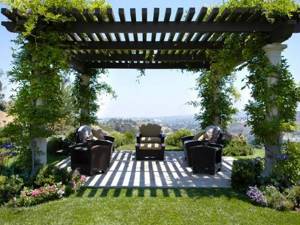
Classic pergola design Source pinterest.com
With the help of a pergola, designers combine different parts of an ornamental garden, decorate the main entrance to the house, disguise unsightly buildings, create shady corners in which a cozy recreation area is then organized. The minimum height of the pergola is 250 cm, the width of the structure must necessarily be greater than the height. Otherwise, the overall decorative element will not look very organic. Plants should be planted only at one support or at two, the rest should remain free. Then the decor used will look easy. Transparency is the main sign of proper design.
Rope pull
It has two supporting elements, they are dug into the ground or concreted, and wire, thread ropes or chains are stretched between the supports. A climbing rose or maiden grapes are planted below under the tension. In a year, one bush grows up to three, three and a half meters, both plants are highly creeping, they can independently attach to any surface (even glass). Over time, the plants grow well and in some places completely cover the support mesh. A very interesting green composition is created, through which the rays of the sun break through. Due to this, it looks very light, airy and elegant. You can see such decorative elements in the Bagatelle Gardens (Paris) and Regent's Park (London).
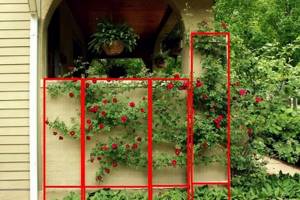
Mesh stretch for climbing roses Source pinterest.com
Metal grate
This is a type of rope pull. It is used to hide unsightly boundaries of the local area and to separate functional zones. You can mount it directly on a fence, on a sheer wall. Using a metal lattice, you can connect adjacent pergola supports. Lianas are planted along them, which, growing, allow the formation of a continuous green barrier.
Hedge
The basis for its creation is a fence or screen. Climbing vines (ivy and wild grapes) grow along them. As a result, a solid green wall is formed, which helps to hide the area from prying eyes, contain street dust and prevent it from penetrating deep into the local area.
See also: Contacts of companies that specialize in landscape design.
Arch
In landscape design, this element is presented in the form of a ceiling connecting the top points of two supports. It can be made using different materials, created from stone and concrete, brick and wood. Using arches, designers often connect two parts of the garden and form a transition from one zone to another.
The location for installing the arch is selected with special care. It looks beautiful if something spacious or unusual opens behind it (a lake, a pond, a fountain, a lush flowering bush). The height of the arch is determined using the following criteria: a person passing through it should not touch the upper arch with his head, plants twining around the arch should not catch clothes and hair with their shoots.
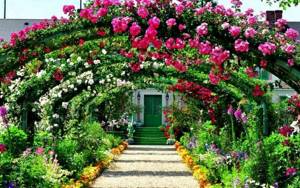
Several arches framing the path Source yandex.ru
There are techniques that help visually change the perception of the area of a site. If you install several arches at equal distances from each other and border them with a straight path going deep into the local area, the area will visually appear much longer. It is better to plant honeysuckle, morning glory or clematis near the arches. Clematis has large, colorful flowers that bloom from late spring to fall. The plant does not require special care; it does not need to be pruned. It is able to “conquer” any space on the site, but when planting it, you must remember that this clematis will definitely be the king of the garden.
Hanging containers
To create them, containers of different shapes and sizes are used. They are suspended from fastenings using chains or ropes, and filled with soil into which mineral fertilizers have been previously mixed. Plants that can easily tolerate heat and drought and be wind-resistant are selected for planting. Petunias have all of the above qualities.
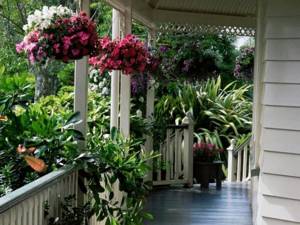
Hanging containers on an open terrace Source deltaangelgroup.com
Flower containers
They are used where it is not possible to organize ordinary flower beds. Often, open terraces and the front entrance to the house are decorated in this way, mini-compositions are created that complement the flower beds or mixborders, linking the floral design into one coherent whole. This creates migrating landscaping, which helps to change scenery if necessary.
Flower containers used to create vertical gardening create the impression of a dynamic garden. If the owners want to decorate a separate corner of the garden in a special way before guests arrive, they can remove the containers with flowers and hang them over the pergola. This technique helps to quickly decorate the most hopeless corner of the dacha. The pots themselves play a style-forming role. This is a decorative element with which you can easily emphasize the chosen thematic concept or support it by filling in empty spaces.
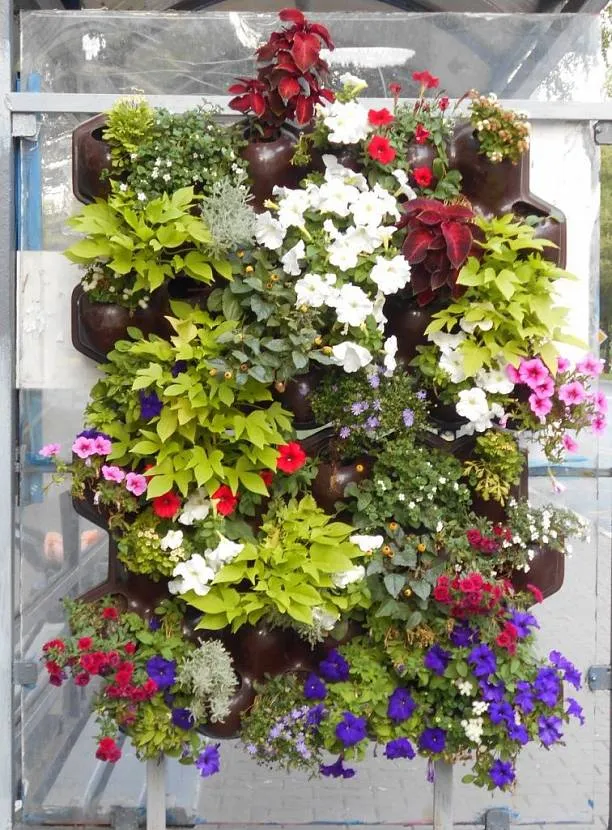
Beautiful flower containers Source pikabu.ru
General information
What is phytowall?
A phytowall is an originally designed composition made from indoor plants, which will decorate the interior for at least 5 years, and with proper care much longer. The walls are built with plants in such a way that you don’t have to constantly worry about watering - it’s all done automatically. But still some care does not fit. If you make living walls in the form of a bright green carpet, you will need to trim the plantings regularly, and if you choose “Jungle”, then they can grow as they want, the main thing is to remove dried leaves and flowers.
Vertical gardening in the interior gives the room uniqueness and unpredictability. “Green wall” is used to decorate restaurants, shops, offices, as well as to decorate the premises of car dealerships, airports and apartments.
What are the advantages of phytowall?
A phytowall differs from other elements for landscaping in that only unpretentious plants that are similar in watering regime are selected for it.
Their choice is huge, and their use provides the following advantages:
Noise insulation – plants grown in the phytomodule and the structure as a whole have the ability to absorb sounds and vibrations of the wall on which it is located.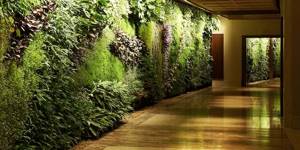
- Appearance – With this addition you will get a stylish environment and decor in the form of a real living picture that will improve the quality of negotiations, bring comfort and show that you want to protect the environment.
- Health – a living wall has an extremely positive effect on health and refreshes stuffy offices. Flowers help purify the air and, thanks to their design, can zone rooms.
- Area – when using vertical gardening in the interior, you can grow many interesting and beautiful plants even in a small area. Even the number of plants that fit on 1 m2 of phytomodule will not fit on the windowsill in an apartment. Thanks to so many plants, you can perfectly humidify the air and free up space.
- Convenience - the world has become so active that many even have lunch on the subway with the food they prepared in the morning. Not every person has the opportunity to constantly monitor the watering of plants. When choosing a modern system, you will definitely find ones that are equipped with automatic watering and are easy to care for.
Peculiarities
There are different systems, for example, live wallpaper, vertical flower beds in felt pockets, the Green Sky system, Green Wall phyto-pictures, HydroFalls phytomodule.
Green Wall irrigation cycles differ in autonomous irrigation mode (closed cycle) and irrigation that is connected to water pipes, i.e. open loop. It is very important that vertical flower beds do not require soil, since the plants are grown hydroponically. This facilitates the process and weight of the structure, as well as maintenance. The plants hardly get sick and are full of health.
Green Sky
Green Sky phytomodules have become incredibly popular. The peculiarity of this system is that replanting is not required for landscaping, since thanks to the Green Sky design, the plant is immediately planted in removable pots. Installation of this system is possible in any area, and plants of different shapes and sizes can be used, which feel comfortable and will never fall out. This makes it possible to do vertical gardening even in an apartment!
The phytowall has an automatic watering function thanks to the use of a tube system. Water circulates through them, which is pumped by a pump. Water is pumped into the container that comes with the kit and from it water flows to the plants according to a certain regime programmed in the timer. Irrigation occurs from top to bottom through a tube, which is not visible, since it is hidden in the panel.
The panel itself is made in the form of a multi-level nest for pots. You can easily adjust the height of the shelves. The design of the modules makes it possible to rearrange plants so that interesting patterns of flowers can be made. The pot holders are movable and make it possible to tilt the flower at any angle.
It’s interesting that if you don’t change anything in the system, then on 1 m2 of the Green Sky system you can place from 55 to 60 flower pots, and the total weight of the structure will be up to 50 kg.
HydroFalls
This green wall is made in the form of a panel that has 4 small built-in pots and the flowers are planted directly in them. Such vertical flower beds are irrigated with liquid, which is poured into a tray. Thanks to the built-in sensor, you can always know the water level. HydroFalls modules can be mounted both along the length and width of the wall.
Green Wall phyto-pictures
Such walls are thought through to the smallest detail. Plants and the composition of them do not appear immediately - first they make a project. The general appearance of vertical gardening is designed in accordance with the style of the room, and plants that bloom are chosen not by color, but, on the contrary, as accents and additions. When installing modules, they also think about lighting. The walls look great with green waterfalls and inscriptions on the green cover.
Such vertical gardening designs are thought out to the smallest detail, even the combination of plants in leaf shape and color, texture, combination of glossy and matte surfaces.
Please note that Green Wall phyto-paintings can be of any size, and can be located either on part of the wall or over the entire area. You can also make paintings with fresh flowers.
Live wallpapers and growing pictures
Green wallpaper made from plants looks extraordinary and impressive. Such phytowalls can be decorated with succulents, moss and lichen. These stabilized plants are different from others - their fibers are impregnated with special substances that give them nutrition and life. They do not require care or watering. The walls will look as if frozen, although the plants will feel juicy, elastic and fresh to the touch.
Living paintings are made in special frames, the thickness of which is no more than 10 cm. I would like to note that technology does not stand still, and thanks to recent developments, thinner frames can be chosen. The arrangement of the paintings has auto-irrigation. The paintings can be of any size, the minimum is 40*40 cm. You can even place the painting in the bathroom, and add additional lighting to the frame. The lamps are not incandescent and will not burn the leaves of the plants. As the plants grow, the picture will change, and over time the author’s new ideas will reveal to you.
Choosing the right plants
To create vertical gardening, designers like to use annuals and perennials. In order for the final result to please you, it is necessary to adhere to the general rules when choosing flowers, shrubs and vines:
- Before you create a composition, you need to clearly imagine in your head what the finished picture will look like. This will help you understand where and what plants to plant, how to make the formed composition look harmonious.
- It is important to choose the right flowers, to use the most successful options for the neighborhood in terms of flowering time and the color scheme itself . You need to understand that it is useful to use some plants to create arches , and others to decorate a pergola .
- To create a vertical, you need support; its shape and type must fit perfectly into the chosen stylistic concept.
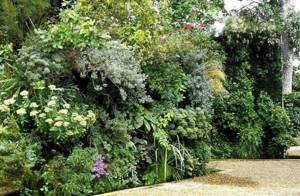
It is useful to plant plants taking into account the cardinal directions. For example, camellia and ivy, mock orange and capuchin do well on the north side. On the west side it is better to plant magnolia grandiflora and wisteria, rope and Californian carpenteria. On the southern and eastern warmest side, climbing rose, honeysuckle, pyracantha, hydrangea and Chinese lemongrass develop well. Schisandra is not only an ornamental plant. If you brew its berries or seeds, you will get a very healthy tonic drink.
The best plants for landscaping
So, the designs have been chosen, the plan has been thought out and approved. The only thing left to do is to choose and buy plants for vertical gardening. Depending on the chosen design and personal preferences, you can choose the following representatives of the flora:
- So-called ampelous plants. They are planted in hanging pots: begonia, petunia, dichondra, etc.
- Plants with climbing stems. They are used near trellises and arches: climbing roses, ordinary grapes, actinidia, honeysuckle.
- Traditional vegetables. You can place them in a pot or along a vertical structure: peas, beans, cucumbers, tomatoes.
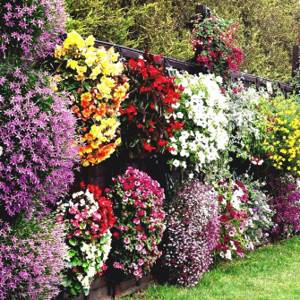
Beautiful plants for landscaping
Video description
The video shows several vertical gardening ideas for your dacha:
Perennials
They are best suited for creating solid green or flowery carpets. Experts recommend giving preference to vines. The round-leaved tree plier takes root well in the Russian climate. It grows very quickly and can rise to a height of up to ten meters. The leaves of this vine are large, hard to the touch, similar to leather. In autumn they change their color to bright yellow.
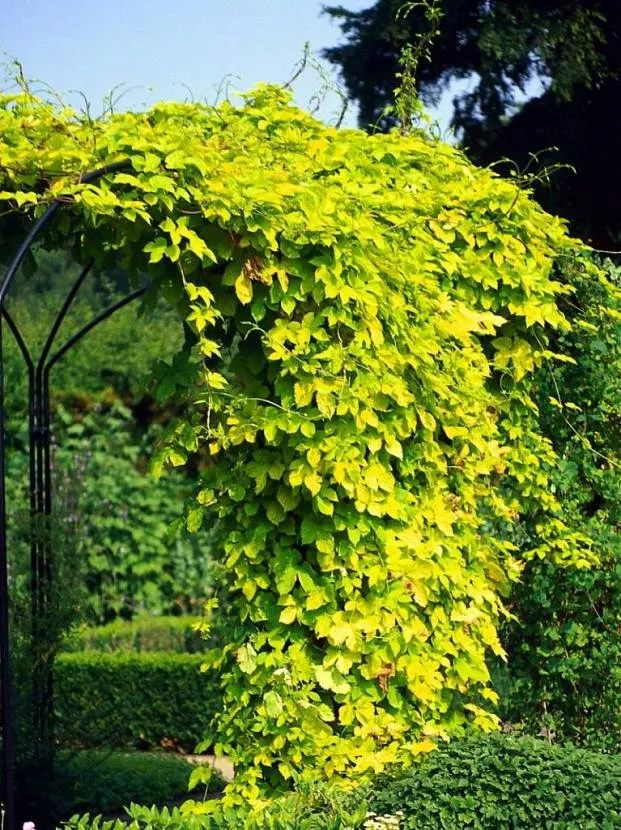
Round-leaved wood pliers in landscape gardening Source ar.pinterest.com
Video description
The video shows vertical gardening of houses using ordinary ivy:
Annuals
Plants that live for a year are very capricious. They do not tolerate temperature changes and frost well. They need to be grown by sowing seeds; sprouted seedlings are planted in the ground only at the end of May or beginning of June. Marigolds, petunia, brachycoma, decorative beans and purslane are most suitable for the Russian climate.
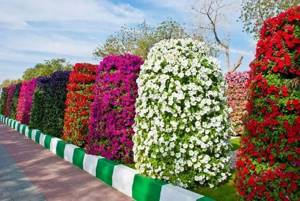
An original element of vertical floral gardening created with the help of petunias Source selinausar.jimdo.com
Master class on creating a phytomodule
Independent implementation of ideas for vertical gardening indoors is based on compliance with a number of rules and requirements, including the correct selection of materials. Understanding these basic points will allow you to create a phytomodule of any complexity.
Phytowall device
Project development and preparation
At this stage, it is important to pay attention to the following points.
- The size of the future structure. It is determined taking into account your ability to select and plant plants, care for them, the area of the room and its stylistic solution.
- Selection of plants. Some of them should serve as a green background, and some as bright and colorful accents. In this case, it is important that the growth rate and development characteristics of plants coincide. This will make caring for them much easier.
- Choosing an irrigation system. You need to decide whether you will water the plants manually or provide them with automatic watering.
- The presence of other functional elements and decor. Lighting, decorative stones, shells, branches, etc.
Plant placement option
On a piece of paper using felt-tip pens or colored pencils, sketch out all the main structural elements and outline the location of each plant. Subsequently, strictly adhere to this scheme.
Frame and waterproofing of the phytomodule
The frame is a strong and reliable base on which the phytomodule watering system is installed and the plants are placed. It is not recommended to attach the frame to a plasterboard wall if the planned size of the “green” decoration is larger than average.
Wooden slats and bars, plastic pipes of the appropriate cross-section, and metal profiles can be successfully used as materials for making the base. Depending on the size of the module, the frame can be one selected element, a frame or a grid of them. Self-tapping screws are usually used to attach the base to the wall.
Homemade wooden frame for phytomodule
Some key points:
- If you use soil to plant plants, then when watering it will make the entire structure even heavier.
- When choosing material for the frame, keep in mind that it should be 2–3 cm behind the wall. This is necessary to ensure ventilation of the structure.
- Wooden frame elements must first be impregnated with agents that prevent rotting.
The wall will be protected from moisture by a layer of waterproofing covering the frame. It can be PVC sheets, polycarbonate or even thick film.
Synthetic felt pockets
Watering system and planting
To plant plants, you will need a specially sewn canvas with pockets, attached over the waterproofing layer using self-tapping screws, metal staples or nails. To create it, it is recommended to use a material that is resistant to decay processes, but does not interfere with the fixation and growth of roots in it. The best option is synthetic (polymer) felt.
Plants in pockets
If you are planning to install an automatic irrigation system, then the felt base should have not only pockets for greenery, but also narrow tunnels for installing pipes. What does the system for watering a phytomodule look like? Quite simple.
Option #1. A water pipe with holes for irrigation along its entire length is mounted in its upper part (or hidden in felt). On one side it is sealed with a plug, and on the other, a tube or thin hose from the water pump is connected to it. She, in turn, is immersed in a container of water located at the bottom of the structure.
Irrigation system operation
Option #2. The entire structure is permeated by a system of supply pipes. They are brought to each pocket with a plant. Watering is carried out using the same pump. Ideal if you don't skimp on the timer. Its presence will allow you to set time intervals at which the water supply pump will turn on.
Phytowall with water container
Note! Plants can be planted not only in a felt base, but also in small pots or long narrow boxes. For them, it is necessary to provide reliable fastenings in advance.
Ready-made plastic pots-pockets
A green carpet on the wall is obtained by planting seeds or young plants in a small amount of soil or growing them hydroponically (supplying only a nutrient solution).
Planting plants in phytomodule boxes
Proper care of the phytomodule
Caring for a phytowall consists of regular and sufficient watering, pruning plants and removing damaged shoots. Adjust watering the first time after planting. To do this, set the watering mode twice a day for 30 minutes each. Literally in 2-3 days you will understand whether this is enough or not.
The formation of plants is carried out by pinching new buds and shoots. This will allow them to grow not in length, but in width, which is preferable.
Objectively assess the scale of work to create a phytowall. If you do not have the time or appropriate skills, then it is better to entrust this matter to professionals. They will select the most suitable option for you.
Three rules for vertical gardening
From all of the above, it is clear that vertical gardening is the most affordable and effective way to improve the local area. In order to do everything correctly, you must adhere to the following recommendations.
It is important to clearly formulate and imagine the end goal. A schematic drawing helps visualize expectations. If you do everything chaotically, very soon the area will be covered with dense, green, but unmanageable vegetation, which will try to survive other plants. To prevent this, you need to clearly understand what, where and how to plant.
It is important to choose the right plants. The choice depends on the specific tasks at hand: to create a hedge you need to choose some plants, to form a vertical screen others. In the first case, you need something that produces lush greenery, in the second, flowers of extraordinary beauty.
It is recommended to strictly follow the technology for creating vertical gardening. It is extremely simple: plants are planted as close as possible to the supports, at the initial stage they are suspended from them on ropes, and then they need to be helped to correctly wrap around fences, arches, and pergolas. As growth progresses, experts recommend pruning the shoots and cutting off excess leaves. Only the human hand is capable of giving the structure the correct outline and making the decorative element externally neat and attractive.
Vertical gardening at home: suitable plants
Any plants of the bromeliad family are suitable for vertical gardening compositions. These plants do not have a stem. They are a funnel-shaped rosette of leathery leaves. Flowers of plants of the bromeliad family can delight the eye with their appearance for up to six months. But it is worth noting that such plants bloom only once. There is one peculiarity in caring for bromeliads: when watering, it is necessary to moisten not only the soil in which the flower grows, but also the rosette of leaves itself. This is important because plants have small root systems. Such plants are often used for planting on phytowalls. In order for the phytowall to look decorative, it is necessary to plant only mature plants that have recently entered the flowering phase. As soon as the plant loses its decorative function, it should be replaced.
Related article: Pouring a concrete floor on the ground with your own hands
